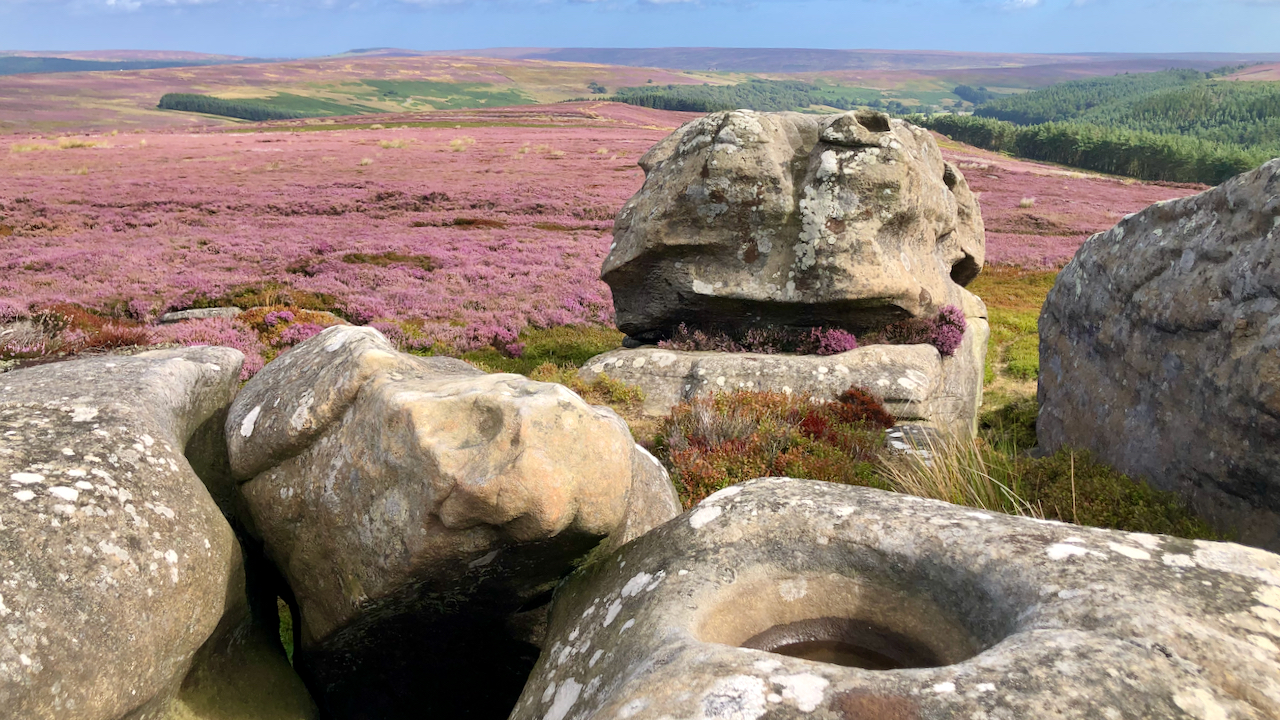Elgee suggests the name Cheese Stones , “probably” originates because the rock was used in local cheese presses1Elgee, Frank. A Ramble in Cleveland | Northern Weekly Gazette | Saturday 20 September 1902 | British Newspaper Archive’. 2022. Britishnewspaperarchive.co.uk <https://www.britishnewspaperarchive.co.uk/viewer/BL/0003075/19020920/126/0012?browse=true> [accessed 8 August 2022]. Now that may be the case but I do not understand why rock from this particular outcrop should be used for pressing cheeses.
In the same article, appearing in the Northern Weekly Gazette in 1902, the future curator of Middlesbrough’s Dorman Museum, also opines that the “rock fonts were carved out by Neolithic man, and used as sacrificial altars in the burial of their dead whose tumuli are in the immediate vicinity“. Although he concedes that natural weathering by rainwater containing gritty particules swirling around has since enlarged them. But in mitigation, he was just 22 when this was published.
Ten years later, in his classic book, The Moorlands of North-Eastern Yorkshire, Elgee makes no mention of this origin theory2Elgee, Frank (1912). The Moorlands of North-Eastern Yorkshire: their natural history and origin. London: A Brown & Sons. Pages 182/3. OCLC 776748510..
The Cheese Stones protude above the heather covered of Middle Rigg, the tongue of Baysdale between Grain Beck and Black Beck. They remind me of the tors of Dartmoor or the Cairngorm plateau.
Their origin though could hardly be more different. These true tors are granite and formed deep underground during the cooling of volcanic rock 400 million years ago. Over the intervening millenia and successive ice ages the softer ground has crept downhill by a process called solufluction3Turnbull, Ronald, “Granite and Grit: A walker’s guide to the geology of British Mountains.” Pages 132-134. 2009. Frances Lincoln Limited..
By contrast, the Cheese Stones are the last fragments of a stratum of Oolite sandstone which formerly covered the Baysdale Moors and which has long since been eroded away4Elgee, Frank (1912). The Moorlands of North-Eastern Yorkshire: their natural history and origin. Page 183. London: A Brown & Sons. OCLC 776748510..
- 1Elgee, Frank. A Ramble in Cleveland | Northern Weekly Gazette | Saturday 20 September 1902 | British Newspaper Archive’. 2022. Britishnewspaperarchive.co.uk <https://www.britishnewspaperarchive.co.uk/viewer/BL/0003075/19020920/126/0012?browse=true> [accessed 8 August 2022]
- 2Elgee, Frank (1912). The Moorlands of North-Eastern Yorkshire: their natural history and origin. London: A Brown & Sons. Pages 182/3. OCLC 776748510.
- 3Turnbull, Ronald, “Granite and Grit: A walker’s guide to the geology of British Mountains.” Pages 132-134. 2009. Frances Lincoln Limited.
- 4Elgee, Frank (1912). The Moorlands of North-Eastern Yorkshire: their natural history and origin. Page 183. London: A Brown & Sons. OCLC 776748510.

Leave a Reply